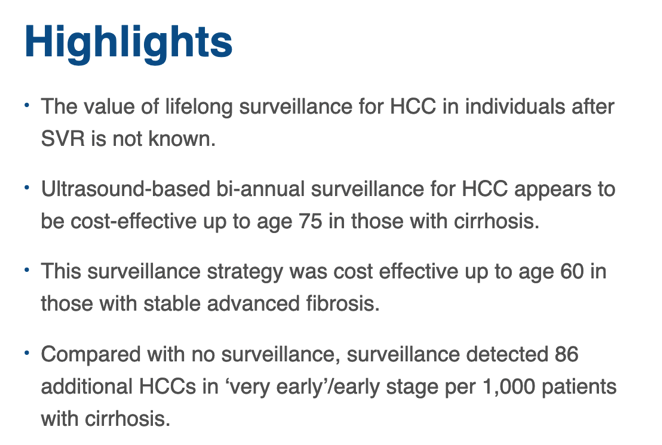| |
Duration and cost-effectiveness of hepatocellular carcinoma
surveillance in hepatitis C patients after viral eradication
|
| |
| |
Download the PDF here
"our results align with the EASL's recommendation of the need for HCC surveillance".....who cares what is "cost-effective if you are the patient, get & continue surveillance for HCC bi-annually

Unlike other major cancers such as breast, prostate, and colorectal, surveillance for HCC remains underutilized in practice.
[45] Several recent observational studies have shown the benefits of routine HCC surveillance.
In conclusion, we found that biannual surveillance for HCC in virologically cured patients with cirrhosis is cost-effective until age 70 and in virologically cured patients with stable advanced fibrosis until the age of 60. Future studies should identify subgroups of patients without cirrhosis who remain at risk of developing HCC and could benefit from a longer duration of HCC surveillance.
the American Association for the Study of Liver Diseases (AASLD) recommends biannual ultrasound-based(with or without alpha-fetoprotein) surveillance for HCC in patients with cirrhosis who achieve virological cure with DAAs, but does not recommend surveillance in patients with advanced fibrosis
the European Association for the Study of the Liver (EASL) guidelines recommend biannual surveillance in patients with cirrhosis as well as bridging fibrosis.
Our study's conclusion supports AASLD and EASL's current HCC surveillance recommendations for HCC surveillance in patients with compensated cirrhosis who achieve virological cure with DAAs. For patients with stable advanced fibrosis - for whom the AASLD and EASL surveillance recommendations differ - our results align with the EASL's recommendation of the need for HCC surveillance. Of note, our study also identified an age cut-off at which to stop surveillance in both cohorts, which is not mentioned in either guideline.
Patients with hepatitis C that has been cured with oral DAAs remain at risk of developing HCC. With the wide use of DAAs, the number of patients virologically cured will rapidly increase in the near future. [5]
In this study, we evaluated the value of routine surveillance for HCC using a decision-analytic model that simulated the natural history of HCC in hepatitis C cured individuals. We found that biannual HCC surveillance is cost-effective in patients with compensated cirrhosis until the age of 70 and in patients with advanced fibrosis until the age of 60. These findings are important because virologically cured patients have a higher life expectancy than patients with active hepatitis C, and lifelong surveillance may not be warranted in this growing cohort.
Early diagnosis of HCC is critical to improved survival - patients with advanced HCC have a median survival of less than 1 year, while patients with early HCC can achieve 5-year survival rates near 70% with resection or transplantation.
[44]
Our analysis found that surveillance could produce a substantial stage shift, in which most HCC would be diagnosed at an early stage. Compared with 'no surveillance' arm, surveillance per 1,000 cirrhosis patients detected 130 additional HCCs in 'very early'/early stage and yielded 51 additional QALYs. Similarly, surveillance per 1,000 patients with advanced fibrosis detected 24 additional HCCs in 'very early'/early stage and yielded 12 additional QALYs.
| |
| |
| |
|
|
|